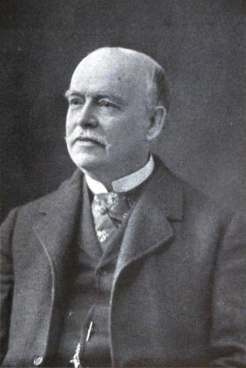
Josiah Cleaveland Cady was an American architect known for his Romanesque Revival designs. He was also a founder of the American Institute of Architects.
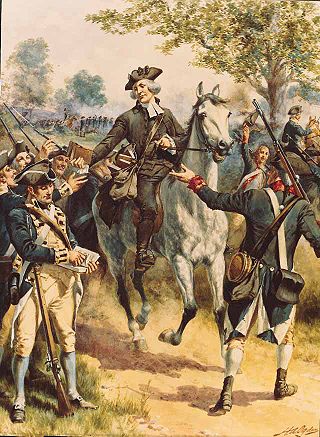
James Caldwell was a Presbyterian minister who played a prominent part in the American Revolution.

Connecticut Farms Presbyterian Church is located at Stuyvesant and Chestnut avenues in Union, Union County, New Jersey, United States, near U.S. Route 22. It is the oldest church in the township.

The Springfield Presbyterian Church is located on Morris Avenue in downtown Springfield, in Union County, New Jersey, United States. The congregation was first established in 1745 and the current church was built in 1791.
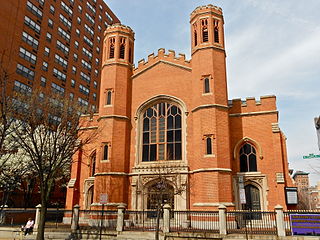
Franklin Street Presbyterian Church and Parsonage is a historic Presbyterian church located at 100 West Franklin Street at Cathedral Street, northwest corner in Baltimore, Maryland, United States. The church is a rectangular Tudor Gothic building dedicated in 1847, with an addition in 1865. The front features two 60 foot flanking octagonal towers are also crenelated and have louvered belfry openings and stained glass Gothic-arched windows. The manse / parsonage at the north end has similar matching walls of brick, heavy Tudor-Gothic window hoods, and battlements atop the roof and was built in 1857.

The Grover Cleveland Birthplace is a historic site located at 207 Bloomfield Avenue in Caldwell, Essex County, New Jersey, United States. It is the only house museum dedicated to U.S. President Grover Cleveland.

The Fairmount Historic District is a 409-acre (166 ha) historic district located along County Route 517 in the Fairmount section of Tewksbury Township, near Califon, in Hunterdon County, New Jersey. It was added to the National Register of Historic Places on December 20, 1996 for its significance in architecture, exploration/settlement, and industry. The district includes 72 contributing buildings that were deemed to be contributing to the historic character of the area, plus five contributing structures, nine contributing sites, and one contributing object. One contributing building is located in Washington Township, Morris County.
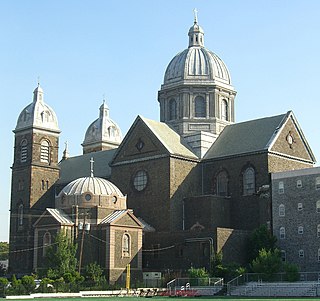
The Monastery and Church of Saint Michael the Archangel, known locally as Saint Michael's Monastery Church, is a state and national historic place in Union City, New Jersey, United States. Formally opened in 1869 and completed in 1875, the grounds of the complex are bounded West Street and Summit Avenue between 18th and 21st Streets. The small street leading to its front entrance from the east is called Monastery Place. At one time the largest Roman Catholic church in Hudson County, it has since become home to a Presbyterian congregation while part of the grounds are used for housing and education. At one time its walls were adorned by artwork by Hildreth Meière, until rain damage prompted their removal from public view.

Mays Landing Presbyterian Church is a historic church built in 1841 and located at Main Street and Cape May Avenue in the Mays Landing section of Hamilton Township in Atlantic County, New Jersey, United States. It was documented by the Historic American Buildings Survey (HABS) in 1938 and was added to the National Register of Historic Places on April 20, 1982, for its significance in architecture and religion. The church was added as a contributing property to the Mays Landing Historic District in 1990.

The First Presbyterian Church is located at 600 Rahway Avenue in Woodbridge Township of Middlesex County, New Jersey, United States. The congregation was founded in 1675. The main part of the church building was completed in 1803. The property, listed as the First Presbyterian Church and Cemetery, was added to the National Register of Historic Places on May 2, 2008, for its significance in art, politics/government, and religion. The historic church was designed and built by Jonathan Freeman, a member of the congregation.

Old Baptist Parsonage is a historic church parsonage at 547 Park Avenue in the township of Scotch Plains in Union County, New Jersey, United States. It is associated with the historic Scotch Plains Baptist Church and cemetery. The parsonage was added to the National Register of Historic Places on January 18, 1973, for its significance in architecture. In 2013, it was included in the Scotch Plains Baptist Church, Parsonage, and Cemetery listing on the NRHP.

Reaville is an unincorporated community located along the border of East Amwell and Raritan townships in Hunterdon County, New Jersey. By the 1830s, it was known as Greenville. It was later renamed after Runkle Rea, the first postmaster in 1850.

The Old Stone Church is a historic sandstone church located in Kingwood Township in Hunterdon County, New Jersey, United States. It was built in 1837 and is now owned by the First Unitarian Universalist Fellowship of Hunterdon County. The church, described using its historic name, Old Stone Presbyterian Church in Kingwood, was added to the National Register of Historic Places on January 25, 2018 for its significance in architecture. The earlier church located here was a smaller stone building built in 1755, called the Old Stone Meetinghouse. The stones from this church were probably used to build the current one. The Kingwood congregation was established in 1728 and grew during the First Great Awakening, with Gilbert Tennent and George Whitefield preaching here in 1739.

The Asbury Historic District is a 288-acre (117 ha) historic district encompassing the community of Asbury in Franklin Township of Warren County, New Jersey. It is bounded by County Route 632, County Route 643, Maple Avenue, Kitchen Road, and School Street and extends along the Musconetcong River into Bethlehem Township of Hunterdon County. It was listed on the National Register of Historic Places on March 19, 1993 for its significance in architecture, industry, religion, community development, politics/government, and commerce. The district includes 141 contributing buildings, a contributing structure, two contributing sites, and four contributing objects.

The Imlaydale Historic District is a 32-acre (13 ha) historic district primarily in Washington Township of Warren County, New Jersey. It was added to the National Register of Historic Places on March 27, 1991 for its significance in architecture, community development, industry, politics/government, and transportation. The listing includes 12 contributing buildings, four contributing structures, and two contributing sites.

The Rockhill Agricultural Historic District is a 1,075-acre (435 ha) historic district located north of Pittstown along County Route 513 in a southern triangular portion of Union Township in Hunterdon County, New Jersey. A small part of the district extends into Franklin Township. The district was added to the National Register of Historic Places on April 5, 1984, for its significance in agriculture during the 18th and 19th centuries.
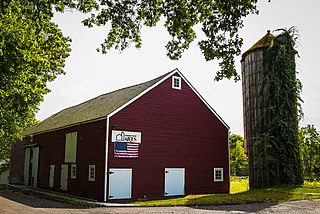
The Kennedy–Martin–Stelle Farmstead is located at 450 King George Road in Bernards Township of Somerset County, New Jersey. The 4.4-acre (1.8 ha) farmstead was added to the National Register of Historic Places on May 5, 2004 for its significance in architecture, education and politics/government from 1762 to 1852. The farmstead includes four contributing buildings and two contributing structures. It is now the home of the Farmstead Arts Center.

The Boudinot–Southard Farmstead is located at 135 North Maple Avenue in Bernards Township of Somerset County, New Jersey. The property was purchased by Elias Boudinot in 1771. Featuring a Colonial Revival farmhouse, it was added to the National Register of Historic Places on December 18, 2009, for its significance in agriculture, architecture, military and politics/government. The 37-acre (15 ha) farmstead includes four contributing buildings and two contributing structures. It is also known as the Ross Farm.

The Morristown District, also known as the Morristown Historic District, is a historic district in the town of Morristown in Morris County, New Jersey. It was added to the National Register of Historic Places on October 30, 1973, for its significance in architecture, communications, education, military, politics, religion, social history, and transportation.

The First Presbyterian Church is located at 57 E. Park Place in the town of Morristown in Morris County, New Jersey. The congregation started worship here in 1733. It received a royal charter from George II of Great Britain in 1756. The current church building was erected in 1894. The stone building features Romanesque Revival architecture and works by Louis Comfort Tiffany. The church was added to the National Register of Historic Places, listed as a contributing property of the Morristown District, on October 30, 1973.
























